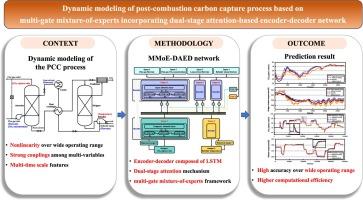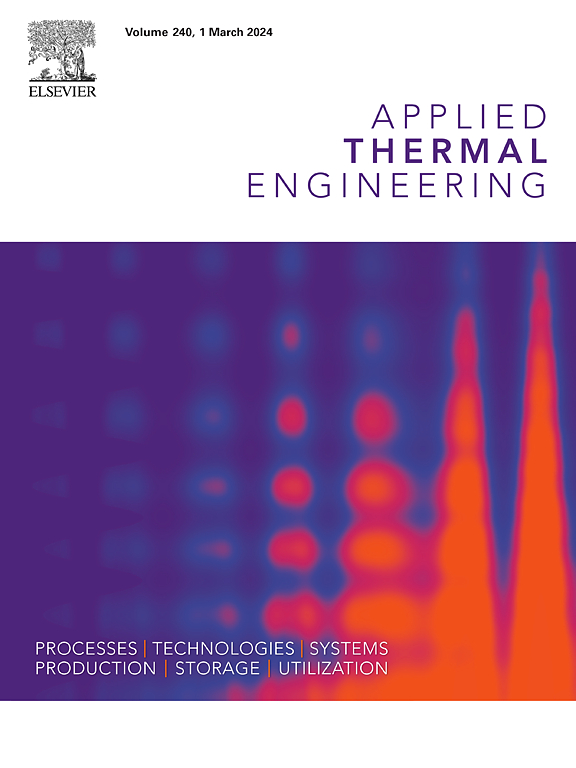基于多门专家混合物的燃烧后碳捕获过程动态建模,其中包含基于双阶段注意力的编码器-解码器网络
IF 6.1
2区 工程技术
Q2 ENERGY & FUELS
引用次数: 0
摘要
基于溶剂的燃烧后碳捕集(PCC)技术是发电和工业设施脱碳的一种前景广阔的近期解决方案。基于模型的过程模拟对于 PCC 过程的优化设计和运行至关重要。最近,数据驱动模型因其适应性强、计算效率高和准确性高而备受关注。然而,PCC 过程的非线性、强耦合和多时间尺度等特点给模型识别带来了巨大挑战。为此,本文提出了一种基于双阶段注意力的多门专家混合编码器-解码器(MMoE-DAED)网络,用于在宽工作条件下对 PCC 过程进行动态建模。由长短时记忆(LSTM)网络组成的编码器-解码器用于从随时间变化的输入数据中提取特征,并学习由过程的惯性和延迟特性引起的复杂动态交互。编码器和解码器分别采用了双阶段注意机制,以选择最相关的输入特征及其在时间序列数据中的相关性。为了提高多输出预测的准确性,实施了考虑多任务学习相关性的多门专家混合物(MMoE)框架。利用 PCC 实验装置的运行数据得出的仿真结果表明,所提出的建模方法能在较宽的运行范围内准确预测二氧化碳捕获率和汽提塔底部温度的稳态值和动态趋势。二氧化碳捕集率的 RMSE、MAPE 和 R2 指数分别为 2.1592、0.0295 和 0.9641,汽提塔底部温度的 RMSE、MAPE 和 R2 指数分别为 0.1491、0.0003 和 0.9833。在 PCC 模拟器上的验证进一步验证了 MMoE-DAED 模型的准确性和效率,与模拟器相比,该模型的计算时间减少了 80.87%。本文为复杂能量转换过程的数据驱动动态建模指明了新方向。本文章由计算机程序翻译,如有差异,请以英文原文为准。

Dynamic modeling of post-combustion carbon capture process based on multi-gate mixture-of-experts incorporating dual-stage attention-based encoder-decoder network
Solvent-based post-combustion carbon capture (PCC) technology is a promising, near-term solution for decarbonizing power generation and industrial facilities. Model-based process simulation is crucial for the optimal design and operation of the PCC process. Recently, data-driven models have gained attention due to their adaptability, efficient computation and high accuracy. However, the nonlinearity, strong couplings and multi-time scale features of the PCC process pose significant challenges for model identification. To this end, this paper proposes a multi-gate mixture-of-experts incorporating dual-stage attention-based encoder-decoder (MMoE-DAED) network for dynamic modeling of the PCC process under wide operating conditions. An encoder-decoder composed of long short-term memory (LSTM) network is employed to extract features from the time-dependent input data and learn the complex dynamic interactions caused by the inertial and delay properties of the process. Dual-stage attention mechanism is incorporated into the encoder and decoder respectively to select the most relevant input features and their correlations within the time series data. To enhance multi-output prediction accuracy, multi-gate mixture-of-experts (MMoE) framework that considers correlations of multitask learning is implemented. Simulation results using operating data from a PCC experimental setup indicate that the proposed modeling approach accurately predicts the steady-state values and dynamic trends of the CO2 capture rate and stripper bottom temperature over a wide operating range. The RMSE, MAPE and R2 indices for the CO2 capture rate are 2.1592, 0.0295, 0.9641, respectively, and for the stripper bottom temperature are 0.1491, 0.0003, 0.9833, respectively. Validations on a PCC simulator further verify the accuracy and efficiency of the MMoE-DAED model, which enables an 80.87% reduction in computation time compared to the simulator. This paper points to a new direction for the data-driven dynamic modeling of complex energy conversion processes.
求助全文
通过发布文献求助,成功后即可免费获取论文全文。
去求助
来源期刊

Applied Thermal Engineering
工程技术-工程:机械
CiteScore
11.30
自引率
15.60%
发文量
1474
审稿时长
57 days
期刊介绍:
Applied Thermal Engineering disseminates novel research related to the design, development and demonstration of components, devices, equipment, technologies and systems involving thermal processes for the production, storage, utilization and conservation of energy, with a focus on engineering application.
The journal publishes high-quality and high-impact Original Research Articles, Review Articles, Short Communications and Letters to the Editor on cutting-edge innovations in research, and recent advances or issues of interest to the thermal engineering community.
 求助内容:
求助内容: 应助结果提醒方式:
应助结果提醒方式:


